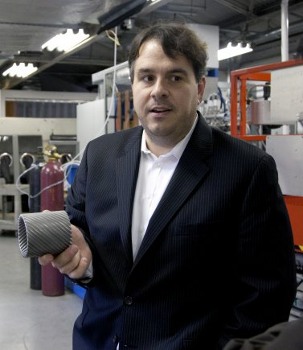 |
| April 24, 2012 | Volume 08 Issue 16 |
Designfax weekly eMagazine
Archives
Partners
Manufacturing Center
Product Spotlight
Modern Applications News
Metalworking Ideas For
Today's Job Shops
Tooling and Production
Strategies for large
metalworking plants
New Army technology holds promise of greater lethality
By Jason Kaneshiro, IMCOM

Engineer Chris Haines holds a cylinder composed of reactive materials. [Photo Credit: Eric Usawicz]
Imagine a warhead with fragments that flare and burn when the warhead detonates.
Now imagine the potential lethality of an artillery shell made almost entirely of that stuff.
Such a theoretical weapon is one of the goals behind the research being conducted by Picatinny Arsenal engineers working at the Advanced Materials Lab in northern New Jersey.
In conventional artillery shells, the explosive force generated upon detonation causes the warhead to break apart. The resulting fragments flung out in all directions at great speed explains how these weapons cause their damage.
But the potential destructive force is increased dramatically with capabilities of reactive materials that can be formed and strengthened to replace the inert materials that make up the rest of the warhead.
The reactive materials form the structure of the warhead rather than simply being loaded into the warhead.
"Structured reactive materials, or SRM, will enhance the lethality of current and future weapons while maintaining or reducing the payload," says Paul Redner, a materials engineer with the Advanced Materials Lab.
"Unlike with more traditional (reactive materials), SRM will be a direct one-to-one replacement of inert components."
The engineers have already made progress in the research, yet challenges remain.
"Despite all of the positive results and lofty goals mentioned above, nothing is ever that simple," says Redner. Among the challenges that researchers are working to overcome, the greatest is how to process components to form more complex shapes.
Through collaboration with other labs, including the Office of Naval Research, researchers are seeking solutions to these technical challenges.
Advances in structured reactive materials are made possible through the continued development of nanomaterials at Picatinny's state-of-the-art lab, which was established to make viable technologies ready for transition to development programs.
"We wish that people would ask to see how we fabricate nanoscaled and nanostructured powders, and how we establish the pedigree for our materials," Redner says.
"We have a wide variety of capabilities and we are open to talk to the ARDEC, PEO Ammunition and the project management communities any time."
Published April 2012
Rate this article
View our terms of use and privacy policy
